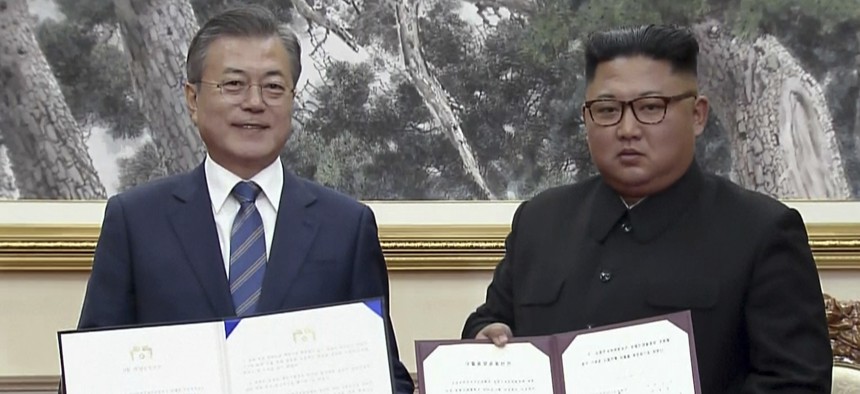
In this image made from video, South Korean President Moon Jae-in, left, and North Korean leader Kim Jong Un pose after signing documents in Pyongyang, North Korea Wednesday, Sept. 19, 2018. Korea Broadcasting System via AP
Moon Brings Korean Peninsula One Step Closer to Peace
As talks with Washington seemed to stall, Seoul created its own path with Pyongyang.
Over the past year, the South Korean government has pursued what could be called the Field of Dreams approach to resolving the North Korean nuclear crisis: If you build peace, they will come. President Moon Jae In, a longtime practitioner of the liberal “Sunshine Policy” of engagement with North Korea, has repeatedly sought to establish facts on the ground that favor diplomacy when the ground has convulsed beneath his feet.
When U.S. and North Korean leaders were threatening each other with nuclear war, Moon seated them an arm’s length away from each other while hosting the “Peace” Olympics in Pyeongchang. When Donald Trump and Kim Jong Un were ready to talk to each other but wary of saying so themselves, South Korean officials did all the talking—shuttling from Pyongyang to Washington and announcing on the White House driveway that Trump had agreed to meet with Kim. When Trump angrily canceled that summit, Moon helped revive it by rushing to the border to consult with North Korea’s leader.
Now Moon has done it again, reporting after more meetings this week with Kim in Pyongyang that North Korea has agreed to shut down a facility for testing missile engines in the presence of foreign experts, to potentially close its main nuclear complex if the United States makes an unspecified concession in return, and to improve North-South ties through measures such as beginning to demilitarize their heavily militarized border and reconnect inter-Korean railways and roads. If it’s starting to look like Trump’s summit gambit is hastening peace on the Korean Peninsula, the truth is that it’s more Moon than Trump who has been driving the process—and peace is still a long way off.
The Moon administration—which includes many officials, including Moon himself, who served under President Roh Moo Hyun during the last era of engagement with North Korea 10 years ago—“is acutely aware that diplomacy with North Korea has been steps forward and backward for decades,” said Leif-Eric Easley of Ewha University in Seoul. “So its strategy is to keep diplomacy constantly moving forward to the point where war is unthinkable on the Korean peninsula.”
Moon traveled to Pyongyang amid a dispute that has paralyzed nuclear talks. The Trump administration has insisted that North Korea take major strides toward denuclearization—such as disclosing all elements of its nuclear-weapons program, allowing international inspectors into the country, and giving up a portion of its nuclear arsenal. Kim has meanwhile demanded that the United States first improve relations with North Korea and offer the North security assurances by formally declaring an end to the Korean War, which came to a halt with a truce in 1953.
Ahead of his trip, Moon had stated that his objectives included finding “an intersecting point between” these positions and facilitating a second summit between Trump and Kim. “What I seek is not a temporary change that may be decided by international conditions, but irreversible and lasting peace that will literally not shake despite how international conditions change,” the South Korean president declared.
Moon is “listening to both sides and then figuring out what path forward … could be possible for both countries, and [then] trying to create the momentum on that path,” the Korea expert Joel Wit told me. “He has to get ahead [of the U.S and North Korea] to some degree. Otherwise this process wouldn’t go anywhere.”
The open question hanging over Moon’s mission, however, is whether the South Korean government, in its determination to forge an unbreakable peace, is getting so far out ahead of the other parties that it is chasing fantasies, as opposed to creating facts. Even as Moon and Kim embraced in Pyongyang, for example, North Korean state media was blasting “gangster-like” American “conservative politicians” for pressuring North Korea to dismantle its nuclear weapons before receiving rewards. This was a nod to yet another stumbling block: divides between Trump advisers such as Secretary of State Mike Pompeoand National-Security Adviser John Bolton, who are reportedly deeply skeptical of North Korea’s sincerity about denuclearizing and concerned about offering Kim concessions prematurely, and Trump himself, who remains enthusiasticabout his relationship with Kim and their ability to “get [a deal] done together.” On Wednesday, Trump described the outcome of this week’s Moon-Kim summit as “very exciting!” (Another tweet from the president referred to a North Korean agreement to allow “Nuclear inspections,” though it's unclear what that meant—this isn't referred to in the joint statement Moon and Kim signed.)
Returning from Pyongyang earlier this month, South Korean officials relayed the encouraging message that Kim was intent on achieving peace and denuclearization before the end of Trump’s first term in office. But the North Korean leader has yet to publicly make this commitment himself, and so far he appears to be continuing to develop many aspects of his nuclear program as Trump’s first term ticks down. While the Moon government has celebrated the liaison office it opened in North Korea last week as a sign of blossoming South-North cooperation, the venture is just as much an indicator of the hard limits of that cooperation in the absence of progress on North Korean denuclearization. The office became embroiled in controversy over concerns that running it could violate international sanctions against North Korea, and North and South Koreans will work on separate floors of the building.
Most controversial of all might be the push for an end-of-war declaration, which was first proposed by Moon and which is now championed most ardently by the North Koreans. South Korean officials tell me the declaration would be merely a symbolic political statement that charts a path toward a more comprehensive peace treaty, as well as giving the Kim government the preliminary reassurance it may need to give up its nuclear deterrent as part of a final peace settlement. But critics in the United States and South Korea warn that the declaration could in practice undermine sanctions against North Korea and the U.S.-South Korea military alliance, while increasing pressure for a peace treaty even if North Korea hasn’t undertaken a corresponding drawdown of its nuclear program.
This week’s “announced North Korean intention for closing nuclear and missile facilities is a positive step,” Easley noted, “but without a timeline, process, or concrete action, many in Washington will question whether this justifies sanctions relief or a meeting with Trump to declare peace.”
“Ultimately, the case for U.S. agreement to a peace declaration depends on the key assumption that Kim’s idea of peace is linked to his relinquishing of nuclear weapons,” the former CIA analyst Jung Pak wrote earlier this week. “Instead, the history of North Korea’s nuclear ambitions, the ideological infrastructure that the Kim dynasty has built over the decades, and the regime’s own public statements strongly suggest that peace—from North Korea’s perspective—is achievable because it has nuclear weapons.” Cho Yoon Je, South Korea’s ambassador to the United States, drew the opposite conclusion when I spoke to him this summer. “Kim Jong Un, I heard, [has] said expressly that ‘If the regime’s security is guaranteed, I don’t need nuclear weapons,’” he noted.
As the arms-control expert Tom Collina has observed, we’ve reached the point in nuclear negotiations where it’s as if North Korea has offered to sell the United States a house, but critical details like the price and the closing date—and even the extent to which North Korea is still upgrading the home—remain unclear. In Pyongyang this week, Moon Jae In attempted to reaffirm that a house is indeed coming on the market and to ferret out more information on its dimensions and the process for making a down payment—to make as clear as possible, in other words, that the house is something more than a dream.




